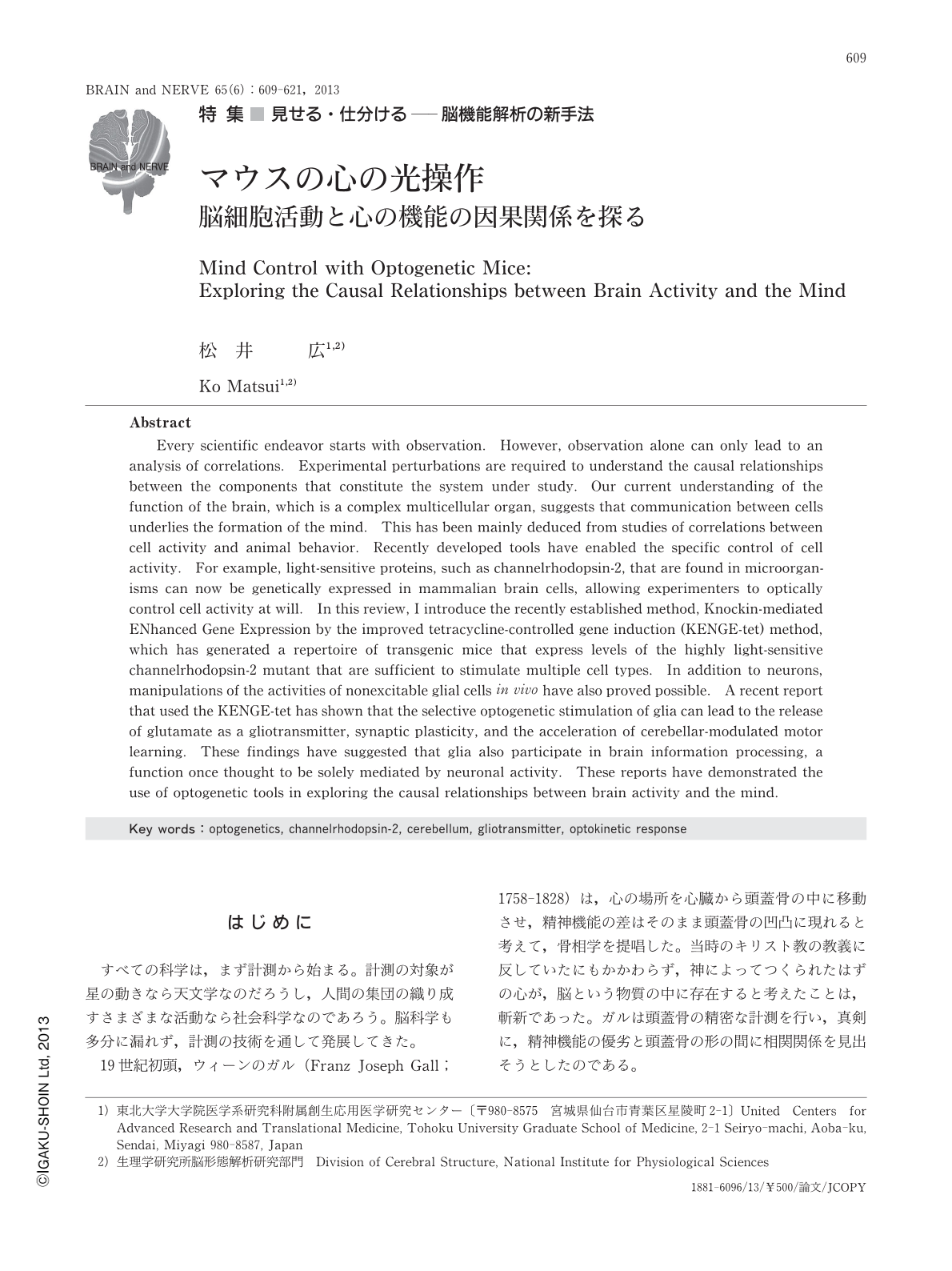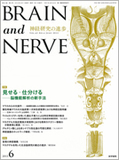Japanese
English
- 有料閲覧
- Abstract 文献概要
- 1ページ目 Look Inside
- 参考文献 Reference
はじめに
すべての科学は,まず計測から始まる。計測の対象が星の動きなら天文学なのだろうし,人間の集団の織り成すさまざまな活動なら社会科学なのであろう。脳科学も多分に漏れず,計測の技術を通して発展してきた。
19世紀初頭,ウィーンのガル(Franz Joseph Gall;1758-1828)は,心の場所を心臓から頭蓋骨の中に移動させ,精神機能の差はそのまま頭蓋骨の凹凸に現れると考えて,骨相学を提唱した。当時のキリスト教の教義に反していたにもかかわらず,神によってつくられたはずの心が,脳という物質の中に存在すると考えたことは,斬新であった。ガルは頭蓋骨の精密な計測を行い,真剣に,精神機能の優劣と頭蓋骨の形の間に相関関係を見出そうとしたのである。
骨相学自体は似非科学であり,また,その後,人種差別や優生学に利用されたという歴史もある。しかし,アプローチとしては今日の脳科学に通じるものがある。fMRIで計測される局所的な脳活動が,どのような脳機能と関わっているのかを探るのと,アプローチの構造としては同じだからである。
今日の実験科学は,相関研究にとどまらず,さらにもう一歩先に進む。計測をしている系に何らかの操作を加えて,それに対する反応を計測するのである。fMRIの例なら,被験者に何らかの学習課題などを負荷し,そのときの脳活動の反応をみる,という方法である。しかし,この研究も厳密な意味で言えば,相関研究の域を出ていない。脳活動のほうを人為的に操作したときに,どういった精神状態が生まれるのか。この因果関係を調べて初めて,脳と心の関係を理解できるようになるのではないだろうか。
1930年頃,カナダの脳神経外科医のペンフィールド(Wilder Graves Penfield;1891-1976)は,てんかん治療のために行われる開頭手術の際に,大脳皮質を電極で刺激し,それによって生じる体性感覚や運動の研究を始めた。また1980年代に開発された,経頭蓋磁気刺激法という手法では,頭蓋骨や脳組織を傷つけずに非侵襲的に脳内活動を刺激する。この方法は,8の字型に巻いたコイルに急激に電流を流すことで,急峻な磁場の変化を生み出し,電磁誘導の法則に従って脳組織内に弱い電流を発生させ,これによって脳内神経細胞の活動を誘起させる。
このような方法によって,脳活動から脳機能へと向かう因果関係を調べる研究が進められているが,これらの方法には刺激の選択性がないという欠点がある。先端のとがった電極を用いた電気刺激の方法でさえ,電極近辺のさまざまな種類の細胞を刺激してしまい,どの細胞の状態の変化によって効果が出てきたのか,実は明らかにできない。電極先端がいかに局所といえども,そこには興奮性神経や抑制性神経が複雑に絡み合い,加えて脳を構成するもう1つの細胞集団,グリア細胞も含めれば,幾種もの細胞が隙間なく敷き詰められているからである。
そこで,遺伝子工学的技術を駆使して動物の特定の細胞に光感受性分子チャネルロドプシン2(channelrhodopsin-2:ChR2)を発現させ,脳に光を当てて,その特定の細胞だけを興奮させる手法が開発された。これによって初めて,どの細胞がどのような心の機能に関わっているのかを直接対応づけて解明することが可能になったのである。多数の楽団員が集い,それぞれが別々の音を奏でながらも,全体としては調和した美しい音楽を作り出すオーケストラのように,われわれの身体を構成する無数の細胞も,バラバラにならずに連携し合うことで,1つの個体としての整合性を保っている。その中の特定の細胞の活動を自在に操ることを可能にしたのが,光操作法である。光操作法を用いて細胞間の生来の連携の一部を乱してやり,それによって生じる不協和音を解読することで,そもそもの生命の調和・調律のしくみを解明することに,筆者らは挑戦している。
Abstract
Every scientific endeavor starts with observation. However, observation alone can only lead to an analysis of correlations. Experimental perturbations are required to understand the causal relationships between the components that constitute the system under study. Our current understanding of the function of the brain, which is a complex multicellular organ, suggests that communication between cells underlies the formation of the mind. This has been mainly deduced from studies of correlations between cell activity and animal behavior. Recently developed tools have enabled the specific control of cell activity. For example, light-sensitive proteins, such as channelrhodopsin-2, that are found in microorganisms can now be genetically expressed in mammalian brain cells, allowing experimenters to optically control cell activity at will. In this review, I introduce the recently established method, Knockin-mediated ENhanced Gene Expression by the improved tetracycline-controlled gene induction (KENGE-tet) method, which has generated a repertoire of transgenic mice that express levels of the highly light-sensitive channelrhodopsin-2 mutant that are sufficient to stimulate multiple cell types. In addition to neurons, manipulations of the activities of nonexcitable glial cells in vivo have also proved possible. A recent report that used the KENGE-tet has shown that the selective optogenetic stimulation of glia can lead to the release of glutamate as a gliotransmitter, synaptic plasticity, and the acceleration of cerebellar-modulated motor learning. These findings have suggested that glia also participate in brain information processing, a function once thought to be solely mediated by neuronal activity. These reports have demonstrated the use of optogenetic tools in exploring the causal relationships between brain activity and the mind.

Copyright © 2013, Igaku-Shoin Ltd. All rights reserved.


